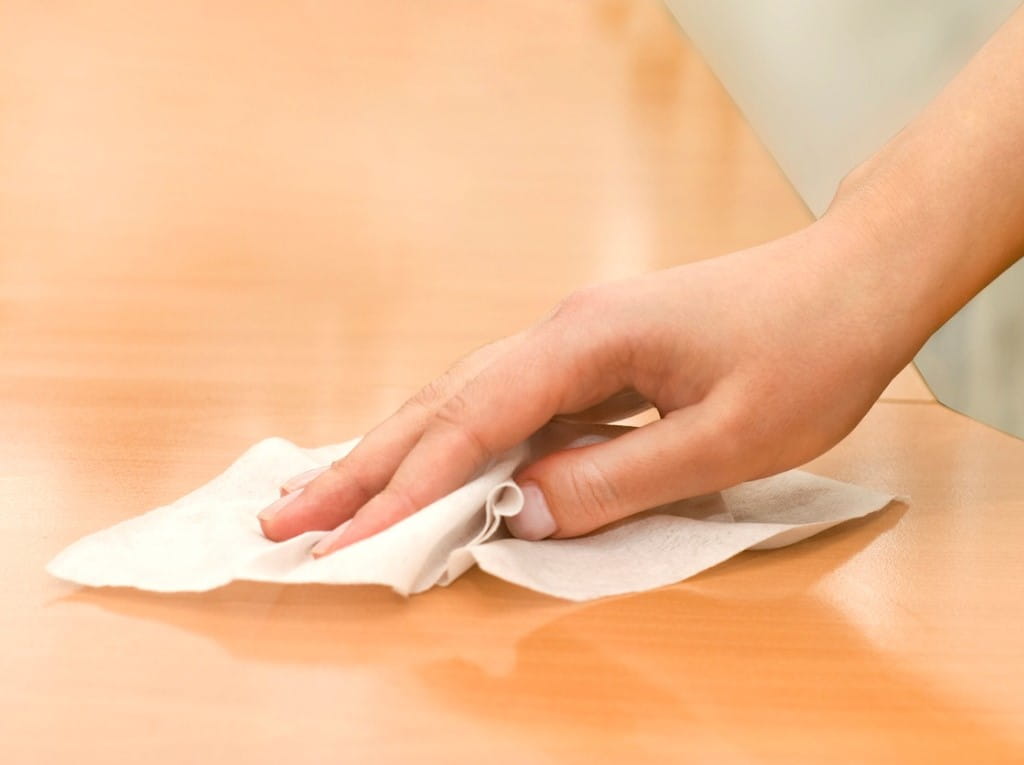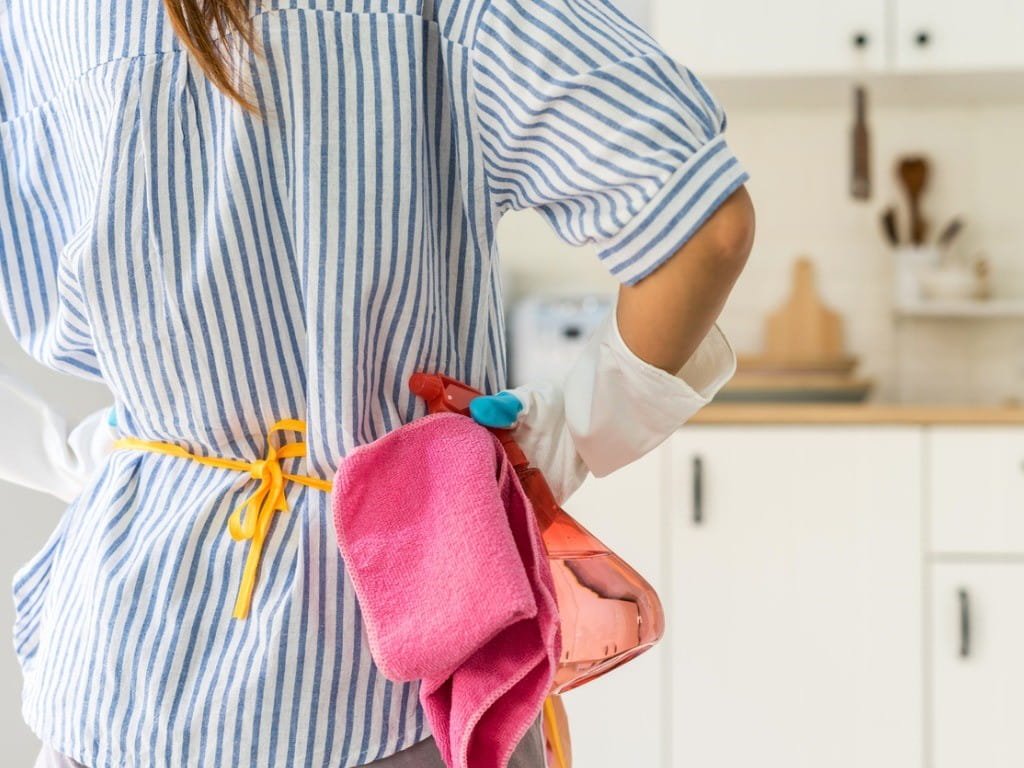Are Cleaning Wipes Safe?

The Bottom Line
Cleaning wipes are available for a variety of surfaces. Since they are meant to be used with bare hands, they are mostly water and are not commonly associated with toxicity.

What are disinfectant wipes made of?
Cleaning wipes are common in modern households. They are used to clean multiple types of hard surfaces, such as stainless steel, countertops, glass, and wooden furniture. These wipes consist of pre-moistened fabric towelettes that contain disinfectants. Wipes can also contain perfumes, preservatives, and other substances. The wipes are typically packaged in plastic containers that have a lid through which the wipe is removed. Each wipe contains a fixed amount of disinfectant, reducing the potential for human error that could occur if people mixed and diluted the disinfectant themselves.
Kitchen disinfecting wipes (including Clorox and Lysol disinfecting wipes) contain detergents, antimicrobials, and other components to boost their effectiveness. With names like alkyl dimethylethylbenzyl ammonium chloride, the detergents in these products sound dangerous. And while these components can cause chemical burns in high concentrations, they are found in much lower concentrations of only 0.01–0.1% in wipes. This concentration is high enough to break apart a bacterial cell wall, just as hand soap does, but not high enough to break down human skin. Some kitchen disinfecting wipes use hydrogen peroxide, isopropyl alcohol, or ethanol in conjunction with a detergent or alone.
Are disinfectant wipes toxic?
Disinfecting wipes are intended to be used by hand, and because of this, they are fairly safe when used properly. However, they are not meant to be mouthed, chewed, or swallowed. Specialized cleaning wipes, like bathroom wipes, can be harsher on the mouth or throat than kitchen wipes. Gastrointestinal irritation, including mouth or throat pain, nausea, and vomiting, are more likely to occur. Other surface cleaning wipes (such as those intended for glass, furniture, and stainless steel) are mild irritants.
To reduce the risk of adverse effects when using disinfecting wipes, first consider whether the use of these products is truly necessary. When simply wiping down a surface, a baby wipe will often accomplish the same cleaning goal and does not contain additional chemicals. If there was raw food on the countertop or if someone in the household has a weakened immune system, then the use of disinfecting wipes is more appropriate.
My skin is burning after coming into contact with a disinfectant wipe. What should I do?
Some people develop reactions on their hands or other skin surfaces after using disinfecting wipes. Household cleaning products often contain preservatives and fragrances, which might cause allergic reactions, including rashes, after contact with human skin.
Furniture and stainless-steel products can contain small amounts of a hydrocarbon or oily substance. These products could cause skin irritation when handled by a child (a child's skin is usually more delicate than an adult’s). Use soap and water to remove any remaining product from the skin, and then use a lotion to soothe the skin. If the irritation continues, a topical corticosteroid like hydrocortisone can be applied. Rubber gloves can help protect the skin from contact with cleaning products, including disinfecting wipes.
Do disinfectant wipes kill COVID-19?
The US Environmental Protection Agency maintains a list of disinfectant products that are known to kill the COVID-19 virus on surfaces. The products on the list are only for use on surfaces, not humans. During the COVID-19 pandemic, there were reports of people who intentionally injected, inhaled, or drank disinfecting solutions. There is no evidence that these uses of disinfecting products prevent or treat COVID-19 infection, and these practices are dangerous.
Do disinfectant wipes kill norovirus?
The ingredients in typical disinfecting wipe products do not appear to be effective for killing norovirus.
Do disinfectant wipes contain bleach?
There are a few disinfectant wipe products that contain bleach, but they are intended for use on surfaces in hospitals or other institutional environments. Many products intended for home use are clearly labeled “bleach free.”
What to do if a disinfectant wipe gets into the mouth.
If a wipe is found in the mouth, remove it, and then rinse the mouth gently with water and offer something to drink.
Can you use disinfecting wipes on skin?
Disinfecting products are designed for use on hard surfaces and are not meant to be used in or on the human body. People who intentionally apply them to their own skin or drink disinfecting wipe solutions can have unwanted and potentially dangerous effects. It is very important to always use cleaning wipes and other disinfecting products only as directed on the package label.
Can you make your own disinfectant wipes?
Disinfecting wipes were sometimes difficult to find in stores during the COVID-19 pandemic. Multiple do-it-yourself recipes for making homemade disinfecting wipes appeared on the internet. Most were unlikely to be as effective as commercial disinfectant wipes, and some were clearly dangerous, especially when bleach was one of the ingredients. Remember to never mix bleach with ammonia, as this can create poisonous chloramine gas. Likewise, mixing bleach with an acid can produce poisonous chlorine gas.
If you are worried about an exposure to cleaning wipes or other hard-surface cleaning products, seek help from experts right away through the webPOISONCONTROL online tool or by phone at 1-800-222-1222. Whether you log on or call, expert assistance is available 24 hours a day.
Kelly Johnson-Arbor, MD
Medical Toxicologist
Professor of Pharmacy Emeritus
Poison Control Media Information
Did you find this page helpful? If so, we need your support. Poison Control is in constant competition with misinformation online. Links to www.poison.org or our webPOISONCONTROL triage tool from other websites and blogs help internet searchers quickly find accurate information and Poison Control’s contact information in an emergency. If you use the content from this page, please provide attribution via a link back to this page, www.poison.org, or https://triage.webpoisoncontrol.org/#!/exclusions. By doing so, you could save a life. Thank you!
Poisoned?
Call 1-800-222-1222 or
Prevention Tips
- Store wipes where children cannot see or reach them.
- Keep cleaning wipes away from other wipes meant to be used on skin to avoid mix-ups.
- Look at the list of ingredients and instructions for use before bringing wipes home.
- Fluid can collect at the bottom of the container and pour out unexpectedly. Do not turn wipe containers upside down.
This Really Happened
An 8-year-old girl wiped her face with a Lysol disinfectant wipe. She did not complain of any pain afterward, but her face was a little red, according to her mother, who called Poison Control for advice. The girl’s mother was told to wash the girl’s face with soap and water and to apply a mild lotion to add moisture. By the following day, the redness had disappeared.
For More Information
References
About List N: disinfectants for coronavirus (COVID-19). US Environmental Protection Agency. Updated April 10, 2024. Accessed June 7, 2024.
What’s in it? Consumer Product Information Database. Accessed June 7, 2024.
Poisoned?
Call 1-800-222-1222 or
Prevention Tips
- Store wipes where children cannot see or reach them.
- Keep cleaning wipes away from other wipes meant to be used on skin to avoid mix-ups.
- Look at the list of ingredients and instructions for use before bringing wipes home.
- Fluid can collect at the bottom of the container and pour out unexpectedly. Do not turn wipe containers upside down.
This Really Happened
An 8-year-old girl wiped her face with a Lysol disinfectant wipe. She did not complain of any pain afterward, but her face was a little red, according to her mother, who called Poison Control for advice. The girl’s mother was told to wash the girl’s face with soap and water and to apply a mild lotion to add moisture. By the following day, the redness had disappeared.
